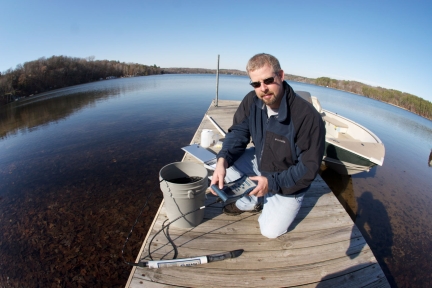
Lakes are central to Minnesota's economy and our way of life, making it imperative that we protect our high quality lakes and work to restore those with poor water quality. The MPCA monitors and assesses lakes around the state to determine if they meet water quality standards. The agency relies on local partners, including soil and water conservation districts, watershed districts, tribes, nonprofit groups, and citizens, to help monitor the more than 10,000 lakes in the state, and offers Surface Water Assessment grants to support local monitoring efforts. Lake enthusiasts can participate in our Volunteer Water Monitoring Program to help track water clarity trends.
Monitoring
The MPCA's lake monitoring primary goals are to:
- determine if lake water quality supports recreational activities such as swimming and boating.
- measure and compare regional differences in water quality.
- identify long-term trends in water quality.
These goals help meet the objectives of the 1972 Clean Water Act to restore and maintain the chemical, physical, and biological integrity of the nation’s waters.
The MPCA's lake monitoring is part of its overall watershed approach, intensively monitoring an average of eight of the state's 80 major watershed each year, on a rotating 10-year cycle. Routine lake sampling occurs once a month from May through September for one or two years, focusing on the water's total phosphorus, chlorophyll-a, and water clarity. It is not possible to sample every lake in Minnesota. The goal is to monitor and assess all recreational lakes larger than 500 acres and a portion of publicly accessible lakes greater than 100 acres.
The MPCA partners with the Minnesota Department of Natural Resources to ensure that lakes are supporting healthy aquatic communities. A subset of lakes are sampled for fish community health each year and work is underway to evaluate plant community health.
Following monitoring, MPCA staff evaluate and assess the data to determine if the lakes meet water quality standards. Based on these results, a total maximum daily load (TMDL) and a watershed and restoration and protect strategy (WRAPS) are completed for each watershed. These reports are the foundation for restoration and protection projects in each watershed.
Sentinel lakes
The Minnesota Department of Natural Resources leads a long-term, collaborative monitoring effort focused on 25 Sentinel Lakes in the state. The program is designed to understand and predict the consequences of land use and climate change on lake habitats in a representative sample of the state's lakes.
This program involves long-term monitoring of water chemistry, fisheries, zooplankton, phytoplankton, habitat, groundwater, and other factors in the lakes, along with detailed assessment of watershed and related characteristics. The MPCA is a partner in this effort and focused on collecting and assessing lake water quality data.